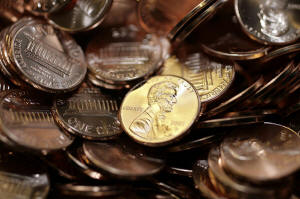Stop making cents: US Mint moves forward with plans to kill the penny
[May 23, 2025]
By FATIMA HUSSEIN and ALAN SUDERMAN
WASHINGTON (AP) — The Trump administration says making cents doesn't
make sense anymore.
The U.S. Mint has made its final order of penny blanks and plans to stop
producing the coin when those run out, a Treasury Department official
confirmed Thursday. This move comes as the cost of making pennies has
increased markedly, by upward of 20% in 2024, according to the Treasury.
By stopping the penny's production, the Treasury expects an immediate
annual savings of $56 million in reduced material costs, according to
the official, who was not authorized to discuss the matter publicly and
spoke on condition of anonymity to preview the news.
In February, President Donald Trump announced that he had ordered his
administration to cease production of the 1-cent coin.
“For far too long the United States has minted pennies which literally
cost us more than 2 cents. This is so wasteful!” Trump wrote at that
time in a post on his Truth Social site. “I have instructed my Secretary
of the US Treasury to stop producing new pennies.”
There are about 114 billion pennies currently in circulation in the
United States — that's $1.14 billion — but they are greatly
underutilized, the Treasury says. The penny was one of the first coins
made by the U.S. Mint after its establishment in 1792.
The nation's treasury secretary has the authority to mint and issue
coins “in amounts the secretary decides are necessary to meet the needs
of the United States.”

Advocates for ditching the penny cite its high production cost — almost
4 cents per penny now, according to the U.S. Mint — and limited utility.
Fans of the penny cite its usefulness in charity drives and relative
bargain in production costs compared with the nickel, which costs almost
14 cents to mint.
The Wall Street Journal first reported the news.
Pennies are the most popular coin made by the U.S. Mint, which reported
making 3.2 billion of them last year. That’s more than half of all the
new coins it made last year.
Congress, which dictates currency specifications such as the size and
metal content of coins, could make Trump’s order permanent through law.
But past congressional efforts to ditch the penny have failed.
Two bipartisan bills to kill the penny permanently were introduced this
year.
[to top of second column]
|

Freshly-made pennies sit in a bin at the U.S. Mint in Denver on Aug.
15, 2007. (AP Photo/David Zalubowski, File)

Sens. Mike Lee, R-Utah, and Jeff Merkley, D-Ore., introduced the
Make Sense Not Cents Act this month. In April, Reps. Lisa McClain,
R-Mich., and Robert Garcia, D-Calif., along with Sens. Cynthia
Lummis, R-Wyo., and Kirsten Gillibrand, D-N.Y., introduced the
Common Cents Act.
Jay Zagorsky, professor of markets, public policy, and law at Boston
University, said that while he supports the move to end penny
production, Congress must include language in any proposed
legislation to require rounding up in pricing, which will eliminate
the demand for pennies.
Zagorsky, who recently published a book called “The Power of Cash:
Why Using Paper Money is Good for You and Society,” said otherwise
simply ditching the penny will only increase demand for nickels,
which are even more expensive, at 14 cents to produce.
“If we suddenly have to produce a lot of nickels — and we lose more
money on producing every nickel — eliminating the penny doesn't make
any sense.”
Mark Weller, executive director of the Americans for Common Cents
group — which conducts research and provides information to Congress
and the Executive Branch on the value and benefits of the penny —
says “there has been an evolution over the past six months that
inevitably the production of the penny will be halted.”
His group advocates for the U.S. to find ways to reduce the cost of
producing the nickel, especially since it will be more in demand
once the penny is totally eliminated from circulation.
“It's incumbent on Treasury to come up with a cheaper way to make
the nickel,” Weller said. “Let's make sure we're making our coins as
least expensively as possible and maintaining the option to use cash
in transactions.”
__
Suderman reported from Richmond, Virginia.
All contents © copyright 2025 Associated Press. All rights reserved |